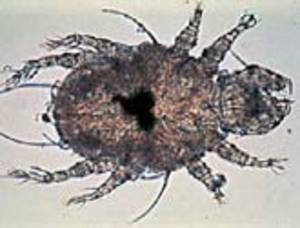What is Cheyletiellia (Walking Dandruff)?

Cheyletiella mites are distributed worldwide, and their distribution in the United States tends to be geographically concentrated in pockets. However they are not a common cause of mange in dogs and cats.
The Cheyletiella yasguri species can cause disease in dogs, while cheyletiella blakei infects cats. Infection occurs through direct contact between one infected animal and another. Both highly-infectous types can be transmitted to humans, resulting in a mild dermatitis and sometimes to pimples on the arms and legs.
The mites are round to oval in shape, with prominent hooks or pincers on their mouths and feathered bristles on their legs and bodies. As with other mites, the adults have four pairs of legs, as do the nymph stages, but the larvae have only three pairs.
The entire life cycle is completed in the outer layer of skin of the unlucky host. The life cycle is thought to be completed within 40 days. Larvae and nymphs die after about 24 hours away from the host, but adults may survive about 10 days off the host.
Symptoms and diagnosis
Cheyletiella (pronounced ki-la-te-el-a) is predominantly a disease of young animals. Some may not show any signs of infection and are regarded as sub-clinical, but these animals are the source of infection for others. The disease is highly contagious and cocker spaniels, poodles and cats are common carriers.
|
"Skin scales are carried through the hair coat by the mites, so the dandruff appears to be moving along the
back of the animal!"
|
The disease is found mainly over the back of the animal with the development of a dry, scaly dermatitis and hair loss. Infestation with these mites is commonly called 'walking dandruff', as skin scales are carried through the hair coat by the mites, so the dandruff appears to be moving along the back of the animal!
The level of itching varies with the severity of the infection. Many cats severely over-groom when affected with this mite, so owners can miss the fact that they are itchy and mistake it for being an extra-clean cat.
Diagnosis is by demonstration of mites in skin scrapings, dandruff and hair tufts. If animals are bathed or shampooed frequently it may be difficult to find mites, but generally these are relatively easy to find compared to other mites in cats and dogs.
|
Treatment options
|
| Ivermectin, fipronil spray and dips of lime-sulfur, permethrin (dogs only) and amitraz (dogs only) are reported to be effective. A Canadian trial demonstrated selamectin to be 100 per cent effective in resolving the disease in cats after two monthly treatments. |
Cheyletiella treatment
The disease is seldom a problem when routine flea prevention is practiced. Infected animals should be isolated and the premises sprayed with an effective insecticide. All animals in contact with the affected pet should be treated due to the infectious nature of the mite.
No products are registered for the treatment of Cheyletiella, however ivermectin, fipronil spray and dips of lime-sulfur, permethrin (dogs only) and amitraz (dogs only) are reported to be effective. A Canadian trial demonstrated selamectin to be 100 per cent effective in resolving the disease in cats after two monthly treatments, with no recurrences at follow-up one year later.
�
�
|
References
|
| Payne P.A., Dryden M.W., Carter G.R. External Parasitic Diseases of Dogs and Cats.
In: A Concise Guide to Infectious and Parasitic Diseases of Dogs and Cats International Veterinary Information
Service, Ithaca NY. www.ivis.org Tilley L.P., Smith F.W.K (2000). The Five Minute Veterinary Consult Canine and Feline. Second Edition. Lippincott Williams & Wilkins, Baltimore. Chailleux, N., Paradis M (2002). Efficacy of selamectin in the treatment of naturally acquired cheyletiellosis in cats. Can Vet J 43:767-770. |